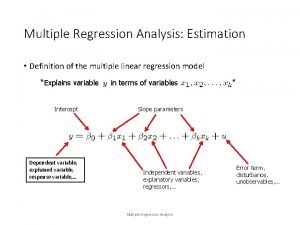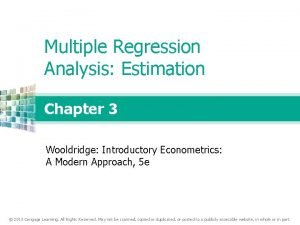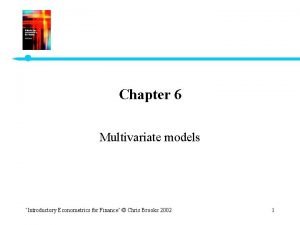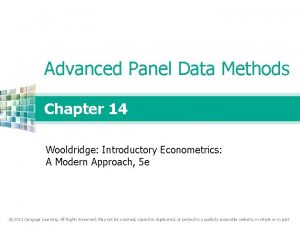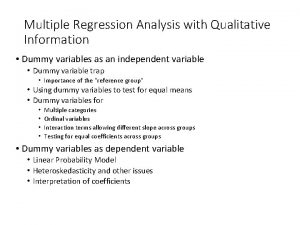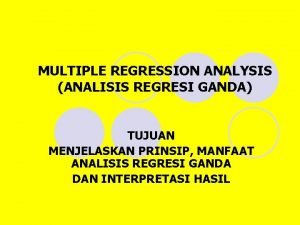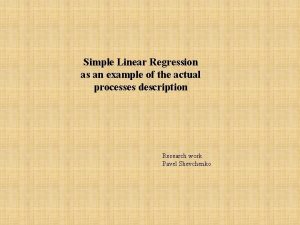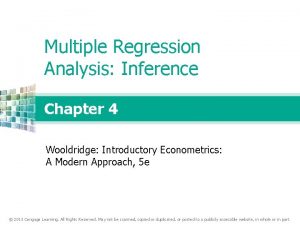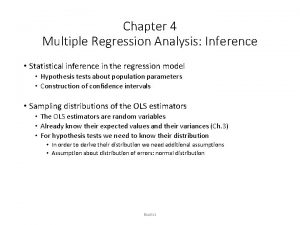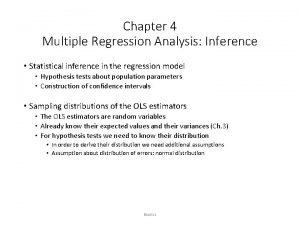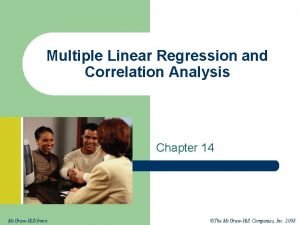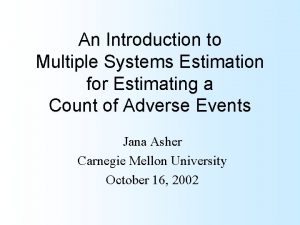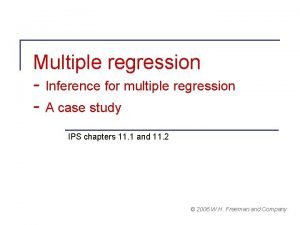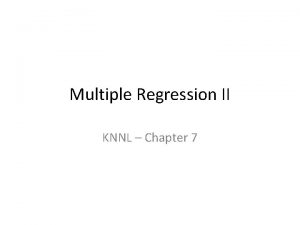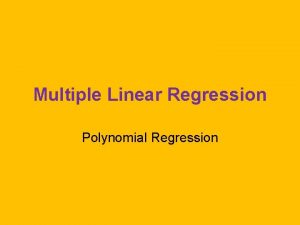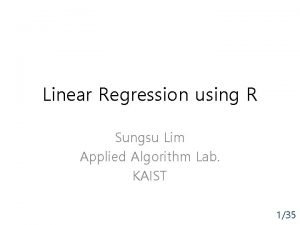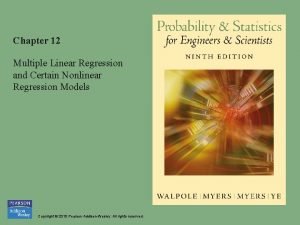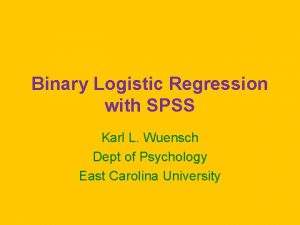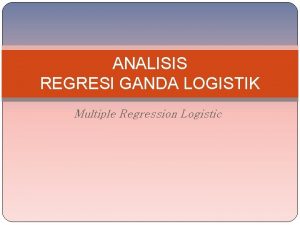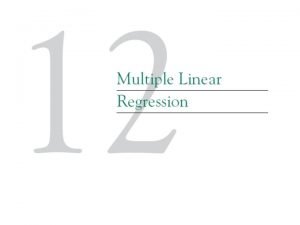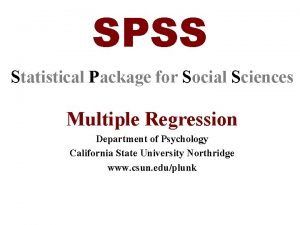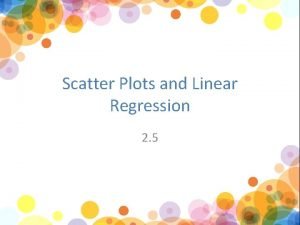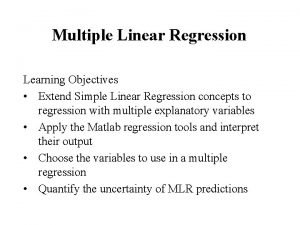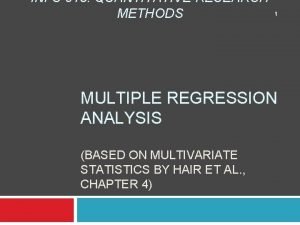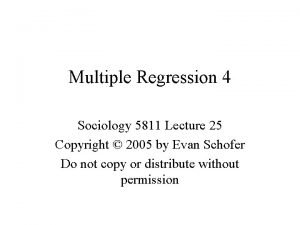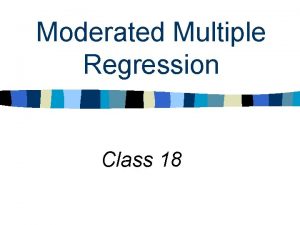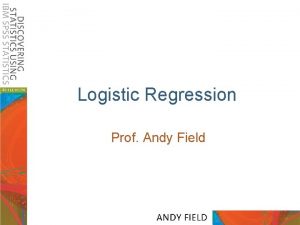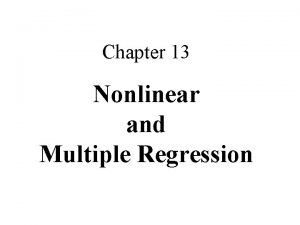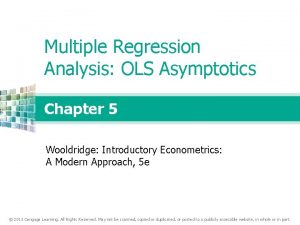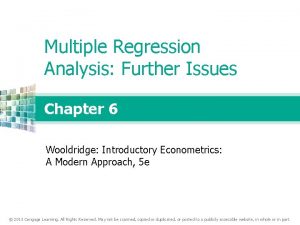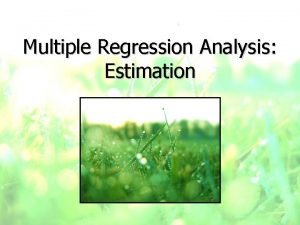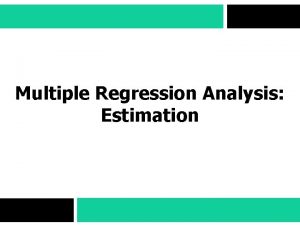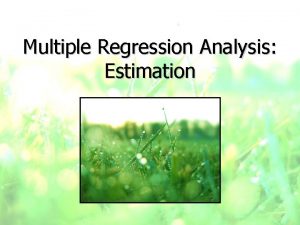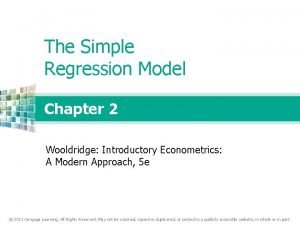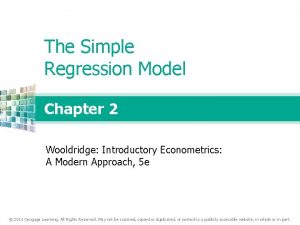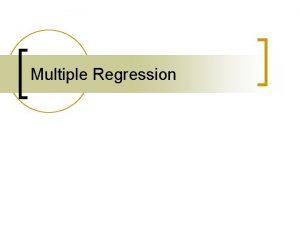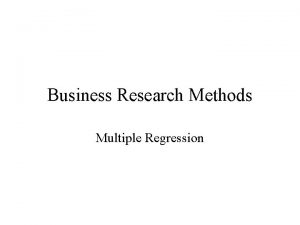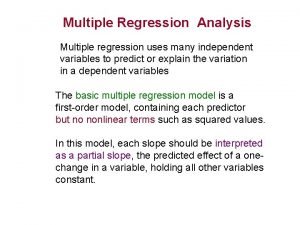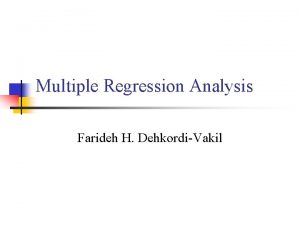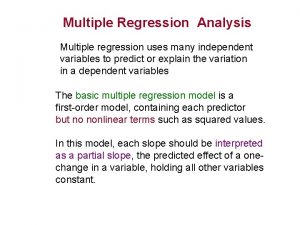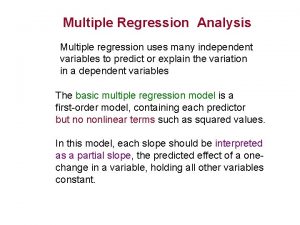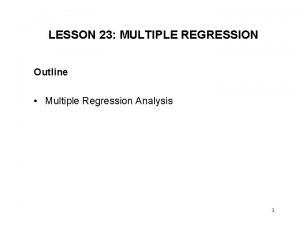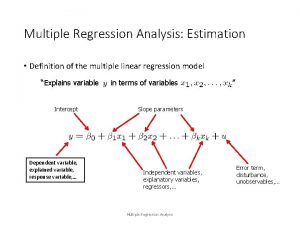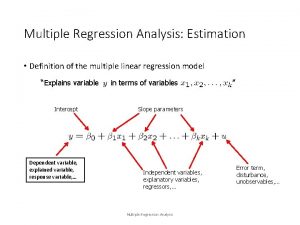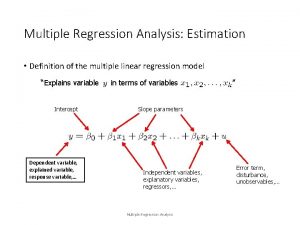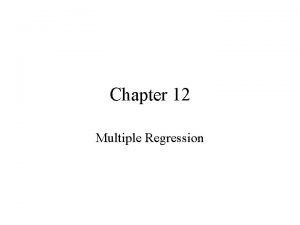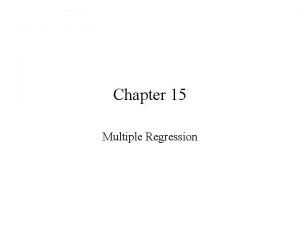Multiple Regression Analysis Estimation Chapter 3 Wooldridge Introductory



































- Slides: 35

Multiple Regression Analysis: Estimation Chapter 3 Wooldridge: Introductory Econometrics: A Modern Approach, 5 e © 2013 Cengage Learning. All Rights Reserved. May not be scanned, copied or duplicated, or posted to a publicly accessible website, in whole or in part.

Multiple Regression Analysis: Estimation Definition of the multiple linear regression model „Explains variable Intercept Dependent variable, explained variable, response variable, … in terms of variables “ Slope parameters Independent variables, explanatory variables, regressors, … Error term, disturbance, unobservables, … © 2013 Cengage Learning. All Rights Reserved. May not be scanned, copied or duplicated, or posted to a publicly accessible website, in whole or in part.

Multiple Regression Analysis: Estimation Motivation for multiple regression Incorporate more explanatory factors into the model Explicitly hold fixed other factors that otherwise would be in Allow for more flexible functional forms Example: Wage equation Now measures effect of education explicitly holding experience fixed All other factors… Hourly wage Years of education Labor market experience © 2013 Cengage Learning. All Rights Reserved. May not be scanned, copied or duplicated, or posted to a publicly accessible website, in whole or in part.

Multiple Regression Analysis: Estimation Example: Average test scores and per student spending Other factors Average standardized test score of school Per student spending at this school Average family income of students at this school Per student spending is likely to be correlated with average family income at a given high school because of school financing Omitting average family income in regression would lead to biased estimate of the effect of spending on average test scores In a simple regression model, effect of per student spending would partly include the effect of family income on test scores © 2013 Cengage Learning. All Rights Reserved. May not be scanned, copied or duplicated, or posted to a publicly accessible website, in whole or in part.

Multiple Regression Analysis: Estimation Example: Family income and family consumption Other factors Family consumption Family income squared Model has two explanatory variables: inome and income squared Consumption is explained as a quadratic function of income One has to be very careful when interpreting the coefficients: By how much does consumption increase if income is increased by one unit? Depends on how much income is already there © 2013 Cengage Learning. All Rights Reserved. May not be scanned, copied or duplicated, or posted to a publicly accessible website, in whole or in part.

Multiple Regression Analysis: Estimation Example: CEO salary, sales and CEO tenure Log of CEO salary Log sales Quadratic function of CEO tenure with firm Model assumes a constant elasticity relationship between CEO salary and the sales of his or her firm Model assumes a quadratic relationship between CEO salary and his or her tenure with the firm Meaning of „linear“ regression The model has to be linear in the parameters (not in the variables) © 2013 Cengage Learning. All Rights Reserved. May not be scanned, copied or duplicated, or posted to a publicly accessible website, in whole or in part.

Multiple Regression Analysis: Estimation OLS Estimation of the multiple regression model Random sample Regression residuals Minimize sum of squared residuals Minimization will be carried out by computer © 2013 Cengage Learning. All Rights Reserved. May not be scanned, copied or duplicated, or posted to a publicly accessible website, in whole or in part.

Multiple Regression Analysis: Estimation Interpretation of the multiple regression model By how much does the dependent variable change if the j-th independent variable is increased by one unit, holding all other independent variables and the error term constant The multiple linear regression model manages to hold the values other explanatory variables fixed even if, in reality, they are correlated with the explanatory variable under consideration of „Ceteris paribus“-interpretation It has still to be assumed that unobserved factors do not change if the explanatory variables are changed © 2013 Cengage Learning. All Rights Reserved. May not be scanned, copied or duplicated, or posted to a publicly accessible website, in whole or in part.

Multiple Regression Analysis: Estimation Example: Determinants of college GPA Grade point average at college High school grade point average Achievement test score Interpretation Holding ACT fixed, another point on high school grade point average is associated with another. 453 points college grade point average Or: If we compare two students with the same ACT, but the hs. GPA of student A is one point higher, we predict student A to have a col. GPA that is. 453 higher than that of student B Holding high school grade point average fixed, another 10 points on ACT are associated with less than one point on college GPA © 2013 Cengage Learning. All Rights Reserved. May not be scanned, copied or duplicated, or posted to a publicly accessible website, in whole or in part.

Multiple Regression Analysis: Estimation „Partialling out“ interpretation of multiple regression One can show that the estimated coefficient of an explanatory variable in a multiple regression can be obtained in two steps: 1) Regress the explanatory variable on all other explanatory variables 2) Regress on the residuals from this regression Why does this procedure work? The residuals from the first regression is the part of the explanatory variable that is uncorrelated with the other explanatory variables The slope coefficient of the second regression therefore represents the isolated effect of the explanatory variable on the dep. variable © 2013 Cengage Learning. All Rights Reserved. May not be scanned, copied or duplicated, or posted to a publicly accessible website, in whole or in part.

Multiple Regression Analysis: Estimation Properties of OLS on any sample of data Fitted values and residuals Fitted or predicted values Residuals Algebraic properties of OLS regression Deviations from regression line sum up to zero Correlations between deviations and regressors are zero Sample averages of y and of the regressors lie on regression line © 2013 Cengage Learning. All Rights Reserved. May not be scanned, copied or duplicated, or posted to a publicly accessible website, in whole or in part.

Multiple Regression Analysis: Estimation Goodness-of-Fit Decomposition of total variation R-squared Alternative expression for R-squared Notice that R-squared can only increase if another explanatory variable is added to the regression R-squared is equal to the squared correlation coefficient between the actual and the predicted value of the dependent variable © 2013 Cengage Learning. All Rights Reserved. May not be scanned, copied or duplicated, or posted to a publicly accessible website, in whole or in part.

Multiple Regression Analysis: Estimation Example: Explaining arrest records Number of times arrested 1986 Proportion prior arrests that led to conviction Months in prison 1986 Quarters employed 1986 Interpretation: Proportion prior arrests +0. 5 ! -. 075 = -7. 5 arrests per 100 men Months in prison +12 ! -. 034(12) = -0. 408 arrests for given man Quarters employed +1 ! -. 104 = -10. 4 arrests per 100 men © 2013 Cengage Learning. All Rights Reserved. May not be scanned, copied or duplicated, or posted to a publicly accessible website, in whole or in part.

Multiple Regression Analysis: Estimation Example: Explaining arrest records (cont. ) An additional explanatory variable is added: Average sentence in prior convictions R-squared increases only slightly Interpretation: Average prior sentence increases number of arrests (? ) Limited additional explanatory power as R-squared increases by little General remark on R-squared Even if R-squared is small (as in the given example), regression may still provide good estimates of ceteris paribus effects © 2013 Cengage Learning. All Rights Reserved. May not be scanned, copied or duplicated, or posted to a publicly accessible website, in whole or in part.

Multiple Regression Analysis: Estimation Standard assumptions for the multiple regression model Assumption MLR. 1 (Linear in parameters) In the population, the relationship between y and the explanatory variables is linear Assumption MLR. 2 (Random sampling) The data is a random sample drawn from the population Each data point therefore follows the population equation © 2013 Cengage Learning. All Rights Reserved. May not be scanned, copied or duplicated, or posted to a publicly accessible website, in whole or in part.

Multiple Regression Analysis: Estimation Standard assumptions for the multiple regression model (cont. ) Assumption MLR. 3 (No perfect collinearity) „In the sample (and therefore in the population), none of the independent variables is constant and there are no exact relationships among the independent variables“ Remarks on MLR. 3 The assumption only rules out perfect collinearity/correlation between explanatory variables; imperfect correlation is allowed If an explanatory variable is a perfect linear combination of other explanatory variables it is superfluous and may be eliminated Constant variables are also ruled out (collinear with intercept) © 2013 Cengage Learning. All Rights Reserved. May not be scanned, copied or duplicated, or posted to a publicly accessible website, in whole or in part.

Multiple Regression Analysis: Estimation Example for perfect collinearity: small sample In a small sample, avginc may accidentally be an exact multiple of expend; it will not be possible to disentangle their separate effects because there is exact covariation Example for perfect collinearity: relationships between regressors Either share. A or share. B will have to be dropped from the regression because there is an exact linear relationship between them: share. A + share. B = 1 © 2013 Cengage Learning. All Rights Reserved. May not be scanned, copied or duplicated, or posted to a publicly accessible website, in whole or in part.

Multiple Regression Analysis: Estimation Standard assumptions for the multiple regression model (cont. ) Assumption MLR. 4 (Zero conditional mean) The value of the explanatory variables must contain no information about the mean of the unobserved factors In a multiple regression model, the zero conditional mean assumption is much more likely to hold because fewer things end up in the error Example: Average test scores If avginc was not included in the regression, it would end up in the error term; it would then be hard to defend that expend is uncorrelated with the error © 2013 Cengage Learning. All Rights Reserved. May not be scanned, copied or duplicated, or posted to a publicly accessible website, in whole or in part.

Multiple Regression Analysis: Estimation Discussion of the zero mean conditional assumption Explanatory variables that are correlated with the error term are called endogenous; endogeneity is a violation of assumption MLR. 4 Explanatory variables that are uncorrelated with the error term are called exogenous; MLR. 4 holds if all explanat. var. are exogenous Exogeneity is the key assumption for a causal interpretation of the regression, and for unbiasedness of the OLS estimators Theorem 3. 1 (Unbiasedness of OLS) Unbiasedness is an average property in repeated samples; in a given sample, the estimates may still be far away from the true values © 2013 Cengage Learning. All Rights Reserved. May not be scanned, copied or duplicated, or posted to a publicly accessible website, in whole or in part.

Multiple Regression Analysis: Estimation Including irrelevant variables in a regression model No problem because . = 0 in the population However, including irrevelant variables may increase sampling variance. Omitting relevant variables: the simple case True model (contains x 1 and x 2) Estimated model (x 2 is omitted) © 2013 Cengage Learning. All Rights Reserved. May not be scanned, copied or duplicated, or posted to a publicly accessible website, in whole or in part.

Multiple Regression Analysis: Estimation Omitted variable bias If y is only regressed on x 1 this will be the estimated intercept If x 1 and x 2 are correlated, assume a linear regression relationship between them If y is only regressed on x 1, this will be the estimated slope on x 1 error term Conclusion: All estimated coefficients will be biased © 2013 Cengage Learning. All Rights Reserved. May not be scanned, copied or duplicated, or posted to a publicly accessible website, in whole or in part.

Multiple Regression Analysis: Estimation Example: Omitting ability in a wage equation Will both be positive The return to education will be overestimated because. It will look as if people with many years of education earn very high wages, but this is partly due to the fact that people with more education are also more able on average. When is there no omitted variable bias? If the omitted variable is irrelevant or uncorrelated © 2013 Cengage Learning. All Rights Reserved. May not be scanned, copied or duplicated, or posted to a publicly accessible website, in whole or in part.

Multiple Regression Analysis: Estimation Omitted variable bias: more general cases True model (contains x 1, x 2 and x 3) Estimated model (x 3 is omitted) No general statements possible about direction of bias Analysis as in simple case if one regressor uncorrelated with others Example: Omitting ability in a wage equation If exper is approximately uncorrelated with educ and abil, then the direction of the omitted variable bias can be as analyzed in the simple two variable case. © 2013 Cengage Learning. All Rights Reserved. May not be scanned, copied or duplicated, or posted to a publicly accessible website, in whole or in part.

Multiple Regression Analysis: Estimation Standard assumptions for the multiple regression model (cont. ) Assumption MLR. 5 (Homoscedasticity) The value of the explanatory variables must contain no information about the variance of the unobserved factors Example: Wage equation This assumption may also be hard to justify in many cases Short hand notation All explanatory variables are collected in a random vector with © 2013 Cengage Learning. All Rights Reserved. May not be scanned, copied or duplicated, or posted to a publicly accessible website, in whole or in part.

Multiple Regression Analysis: Estimation Theorem 3. 2 (Sampling variances of OLS slope estimators) Under assumptions MLR. 1 – MLR. 5: Variance of the error term Total sample variation in explanatory variable xj: R-squared from a regression of explanatory variable xj on all other independent variables (including a constant) © 2013 Cengage Learning. All Rights Reserved. May not be scanned, copied or duplicated, or posted to a publicly accessible website, in whole or in part.

Multiple Regression Analysis: Estimation Components of OLS Variances: 1) The error variance A high error variance increases the sampling variance because there is more „noise“ in the equation A large error variance necessarily makes estimates imprecise The error variance does not decrease with sample size 2) The total sample variation in the explanatory variable More sample variation leads to more precise estimates Total sample variation automatically increases with the sample size Increasing the sample size is thus a way to get more precise estimates © 2013 Cengage Learning. All Rights Reserved. May not be scanned, copied or duplicated, or posted to a publicly accessible website, in whole or in part.

Multiple Regression Analysis: Estimation 3) Linear relationships among the independent variables Regress on all other independent variables (including a constant) The R-squared of this regression will be the higher the better xj can be linearly explained by the other independent variables Sampling variance of variable will be the higher the better explanatory can be linearly explained by other independent variables The problem of almost linearly dependent explanatory variables is called multicollinearity (i. e. for some ) © 2013 Cengage Learning. All Rights Reserved. May not be scanned, copied or duplicated, or posted to a publicly accessible website, in whole or in part.

Multiple Regression Analysis: Estimation An example for multicollinearity Average standardized test score of school Expenditures for teachers Expenditures for instructional materials Other expenditures The different expenditure categories will be strongly correlated because if a school has a lot of resources it will spend a lot on everything. It will be hard to estimate the differential effects of different expenditure categories because all expenditures are either high or low. For precise estimates of the differential effects, one would need information about situations where expenditure categories change differentially. As a consequence, sampling variance of the estimated effects will be large. © 2013 Cengage Learning. All Rights Reserved. May not be scanned, copied or duplicated, or posted to a publicly accessible website, in whole or in part.

Multiple Regression Analysis: Estimation Discussion of the multicollinearity problem In the above example, it would probably be better to lump all expenditure categories together because effects cannot be disentangled In other cases, dropping some independent variables may reduce multicollinearity (but this may lead to omitted variable bias) Only the sampling variance of the variables involved in multicollinearity will be inflated; the estimates of other effects may be very precise Note that multicollinearity is not a violation of MLR. 3 in the strict sense Multicollinearity may be detected through „variance inflation factors“ As an (arbitrary) rule of thumb, the variance inflation factor should not be larger than 10 © 2013 Cengage Learning. All Rights Reserved. May not be scanned, copied or duplicated, or posted to a publicly accessible website, in whole or in part.

Multiple Regression Analysis: Estimation Variances in misspecified models The choice of whether to include a particular variable in a regression can be made by analyzing the tradeoff between bias and variance True population model Estimated model 1 Estimated model 2 It might be the case that the likely omitted variable bias in the misspecified model 2 is overcompensated by a smaller variance © 2013 Cengage Learning. All Rights Reserved. May not be scanned, copied or duplicated, or posted to a publicly accessible website, in whole or in part.

Multiple Regression Analysis: Estimation Variances in misspecified models (cont. ) Conditional on x 1 and x 2 , the variance in model 2 is always smaller than that in model 1 Case 1: Case 2: Conclusion: Do not include irrelevant regressors Trade off bias and variance; Caution: bias will not vanish even in large samples © 2013 Cengage Learning. All Rights Reserved. May not be scanned, copied or duplicated, or posted to a publicly accessible website, in whole or in part.

Multiple Regression Analysis: Estimation Estimating the error variance An unbiased estimate of the error variance can be obtained by substracting the number of estimated regression coefficients from the number of observations. The number of observations minus the number of estimated parameters is also called the degrees of freedom. The n estimated squared residuals in the sum are not completely independent but related through the k+1 equations that define the first order conditions of the minimization problem. Theorem 3. 3 (Unbiased estimator of the error variance) © 2013 Cengage Learning. All Rights Reserved. May not be scanned, copied or duplicated, or posted to a publicly accessible website, in whole or in part.

Multiple Regression Analysis: Estimation of the sampling variances of the OLS estimators The true sampling variation of the estimated Plug in for the unknown The estimated sampling variation of the estimated Note that these formulas are only valid under assumptions MLR. 1 -MLR. 5 (in particular, there has to be homoscedasticity) © 2013 Cengage Learning. All Rights Reserved. May not be scanned, copied or duplicated, or posted to a publicly accessible website, in whole or in part.

Multiple Regression Analysis: Estimation Efficiency of OLS: The Gauss-Markov Theorem Under assumptions MLR. 1 - MLR. 5, OLS is unbiased However, under these assumptions there may be many other estimators that are unbiased Which one is the unbiased estimator with the smallest variance? In order to answer this question one usually limits oneself to linear estimators, i. e. estimators linear in the dependent variable May be an arbitrary function of the sample values of all the explanatory variables; the OLS estimator can be shown to be of this form © 2013 Cengage Learning. All Rights Reserved. May not be scanned, copied or duplicated, or posted to a publicly accessible website, in whole or in part.

Multiple Regression Analysis: Estimation Theorem 3. 4 (Gauss-Markov Theorem) Under assumptions MLR. 1 - MLR. 5, the OLS estimators are the best linear unbiased estimators (BLUEs) of the regression coefficients, i. e. for all for which . OLS is only the best estimator if MLR. 1 – MLR. 5 hold; if there is heteroscedasticity for example, there are better estimators. © 2013 Cengage Learning. All Rights Reserved. May not be scanned, copied or duplicated, or posted to a publicly accessible website, in whole or in part.
 Define multiple regression
Define multiple regression Multiple regression analysis estimation
Multiple regression analysis estimation Econometrics
Econometrics Wooldridge econometrics slides
Wooldridge econometrics slides Simple and multiple linear regression
Simple and multiple linear regression Multiple regression
Multiple regression Multiple regression analysis with qualitative information
Multiple regression analysis with qualitative information Multiple regression analysis adalah
Multiple regression analysis adalah Multiple linear regression analysis formula
Multiple linear regression analysis formula Mse econometrics
Mse econometrics Multiple regression analysis inference
Multiple regression analysis inference Multiple regression analysis inference
Multiple regression analysis inference Multiple regression analysis inference
Multiple regression analysis inference Multiple regression equation
Multiple regression equation Survival analysis vs logistic regression
Survival analysis vs logistic regression Logistic regression vs linear regression
Logistic regression vs linear regression Multiple systems estimation
Multiple systems estimation Multiple linear regression
Multiple linear regression Anova multiple regression
Anova multiple regression Extra sum of squares multiple regression
Extra sum of squares multiple regression Polynomial regression spss
Polynomial regression spss Gradient descent multiple variables
Gradient descent multiple variables Multiple linear regression variance
Multiple linear regression variance Multiple nonlinear regression spss
Multiple nonlinear regression spss Karl wuensch
Karl wuensch Pengertian analisis regresi logistik
Pengertian analisis regresi logistik Multiple linear regression variance
Multiple linear regression variance Hierarchical linear regression spss
Hierarchical linear regression spss Multiple regression scatter plot
Multiple regression scatter plot Kr
Kr Multiple regression research design
Multiple regression research design Multiple regression assumptions spss
Multiple regression assumptions spss Hypothesis for multiple regression
Hypothesis for multiple regression Moderated multiple regression
Moderated multiple regression Andy field logistic regression
Andy field logistic regression Polynomial regression
Polynomial regression
